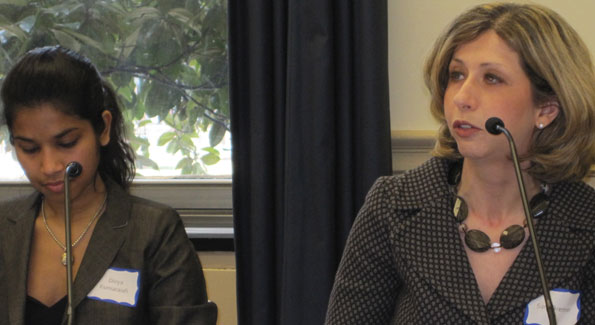A panel of experts define what it is, who it is and how live in the constant tension it requires.
By Jane Hess Collins

(l to r) Social Entrepreneurship panel members Divya Kumaraiah from the White House Domestic Policy Council's Office of Social Innovationand Civic Participation, and Sara Brenner of Community Wealth Ventures. Photo by Jane Hess Collins
Radical creativity vs. structured execution. Long-term solutions vs. short term needs. Accountability vs. experimentation. Innovation vs. risk mitigation. A social entrepreneur lives and thrives in that continual yin and yang.
Each member of the Social Entrepreneurship panel, moderated by GPPI‘s Dr. Steven Rathgeb Smith, kept circling back to the “vs.” as they defined the challenge of a social entrepreneur. The forum was part of Georgetown University’s Public Policy Institute (GPPI) Conference on February 25 at the U.S. Capitol’s Rayburn House Office Building.
Georgetown University’s Center for Public and Nonprofit Leadership director, Dr. Kathy Kretman, was thrilled that the GPPI graduate students chose the nonprofit (third) sector as this year’s conference theme (author’s note-the conference included other discussions and speakers, but I could only attend this panel.) “I love the fact that the students are doing this,” she said, adding that the students are interested in the third sector issues of advocacy, social innovation, and collaboration with local and international government and private industry.
What and who exactly is a social entrepreneur? While it partly depends on who is asked, each panelists defined it as someone who creates social change using entrepreneurial skills and techniques. It’s more than business model or innovation, according to Kretman. Social entrepreneurs create sustainable models that lead to enduring, high-impact organizations.
Panelist Aleta Margolis, founder and executive director for the Center for Inspired Teaching, added that a social entrepreneur solves the underlying social issue as well as the immediate need. Manny Hidalgo, executive director of the Latino Economic Development Corporation, defines a social entrepreneur as anyone who loves learning and embraces change, whether they realize it or not. His low-cost tip for creating the next generation’s social entrepreneurs? Read to them and instill a love of learning. And Sara Brenner, vice president and director of client services for Community Wealth Ventures, said a good social entrepreneur will eventually put herself out of business.
Entire organizations can earn the social entrepreneurs title, with the right mix of leadership, vision, creativity and discipline. Again, it’s all about the balance of mitigating risk, innovating, and determining when to move toward goals or when it’s time to re-evaluate them. Just don’t-please-use an established goal as an excuse to shy away from new ideas or innovations. And engage everyone in those complicated conversations about long term vs. short term goals. No matter what camp you’re in, everyone is part the solution, creating dialogue to help and learn from each other diminishes the fight for funding.
Yin/yang aside, everyone, including Kretman, agreed that advocacy is a social entrepreneur’s biggest role. Divya Kumaraiah, policy assistant for the White House Domestic Policy Council’s Office of Social Innovation and Civic Participation, added that while her office is focusing more on results and evaluation, that shouldn’t discourage nonprofits and other change-makers from innovation. If there’s tension between the results and innovation, Margolis added, it’s time to re-evaluate the outcomes.
The lesson? Hidalgo likened the social entrepreneur journey to the building of a cathedral. The result may take a few centuries, but the end result is beautiful.
Jane Hess Collins helps and encourages people to give back through her writing, speaking, coaching and workshops. She also established game nights for at-risk families throughout the country. You can contact her at www.getoutandgiveback.com.




